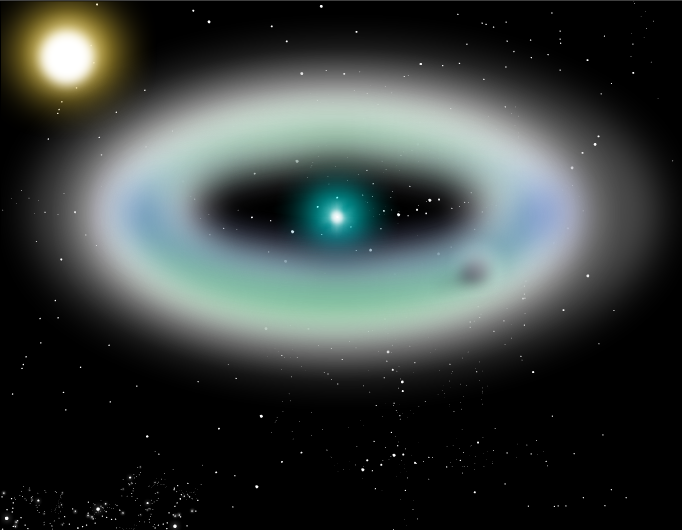Tom Kalbfus
Mongoose
What if we had such a smoke ring in Traveller? We could fix the physics, see below:
http://www.larryniven.net/physics.shtml

Here is the corrected Version.
Actually according to the Calctool, http://www.calctool.org/CALC/phys/astronomy/planet_orbit the black part of the ring would be at a radius of 456,327 km which would give an orbital period of 125.293 minutes, which is about 2 hours. So the numbers seem to work. the escape velocity at the center of the black part of the ring is 539.377 km/sec, should be more than enough to hold onto a standard 6 atmosphere. By the way, 26,000 km is about 4 times the radius of the Earth, not quite big enough to fit a gas giant within the torus. You know asteroids within the smoke ring would be a "Belter's Paradise" not only do you have a breathable atmosphere in which to mine the asteroids, the supernova explosion which made the neutron star would have left a lot of valuable heavy metals behind, like gold and platinum for instance! How would you use this in a Traveller campaign?
http://www.larryniven.net/physics.shtml
I see if you add another 0 to the inner radius of the smoke ring to make it 260,000 km the orbital period at the inner edge becomes 53.8855 minutes. Maybe that is Niven's main error, he dropped a zero!
Here's a big object: The Smoke Ring. It is a torus of gas circling an old neutron star, created from the atmosphere of the planet within the Ring. Its radius is about 26,000 kilometers and it gets light from the star that both it and the neutron star circle. It holds life. By the way, there is a gas torus around Saturn which one of Saturn's SATELLITES (Titan) orbits within (see Niven's N-Space for details on how he was inspired to create the Smoke Ring).
Being so close to the high gravity of the neutron star, things in the Smoke Ring orbit the star pretty quickly. Niven gives a minimum period of 2 hours, while I get a typical period of a little less than 2 MINUTES (using this equation). I don't know what causes the discrepancy, unless it's a mistake on the author's part (this is the mistake I mentioned e-mailing Mr. Niven about). The mass of Voy is implied to be 0.5 solar mass which is about 1033 grams, but to get the right answer, the actual mass of Voy would have to be much less (about 1/10000th of a solar mass), which is a pretty implausible value for the mass of a neutron star mass.
The first time I gave this talk a student asked how a planet could have survived the supernova that created Voy - it's in the book that the planet came later and also that Voy is old enough that it is not rotating anymore and therefore not sweeping a radiation beam through the Smoke Ring periodically. Good questions though.

One of the life forms common in the Ring is the Integral tree. It's pretty big - people actually live on it. Now when people are simply in the Smoke Ring they're in free fall, but what if they live on a tree? It turns out that tides give an equivalent to gravity. The gravity of the neutron star is so great that the ends of the tree should be in significantly different orbits, but instead they're constrained to orbit together. Therefore anything ATTACHED to the upper end of the tree is moving too fast for its orbit and thus feels an acceleration outward.
Meanwhile, anything ATTACHED to the lower end is moving too slowly for its orbit and is accelerated inward towards Voy. The middle of the tree remains in free fall (otherwise the whole tree would accelerate into Voy or out of the Ring) - it's in the right orbit after all. Another way to think about it is that the whole tree is being swung around Voy, which should result in a centrifugal force outward on any object on the tree, but the gravitational force of Voy cancels out the centrifugal force exactly at the center of the tree, too much on the inner tuft and not enough at the outer tuft.
The equation for the acceleration experienced by something ATTACHED to the tree is remarkably simple - it's just 3 times square of the rotation rate of the tree around Voy times the distance of the object from the center of the tree. In other words, it's just the force that would be felt if Voy didn't exist, and the tree were being rotated around its center at the rate omega, plus the differential force due to change in Voy's gravity over the length of the tree (Thanks to Peter Taylor for pointing out a factor-of-3 error in an earlier version of this talk) [Webmaster NOTE: see some writings of Peter Taylor at http://www.ghg.net/redflame].
Unfortunately while the BOOK REPORTS a maximum force of about 1/5 g at the ends of a tree, I get a force of almost 30 gees - probably because of the same miscalculation that caused the error in the period of objects in the Smoke Ring. However, that problem is easily resolved - just make the tree shorter. By the way, the same tidal force that creates pseudo-gravity for objects attached to the tree makes the orientation of integral trees very stable - each end of the tree is being pulled so that it lines up with the radial vector. If the tree ever got out of that orientation, it would oscillate a bit, but then settle down due to the damping effect of air resistance. We'll talk a little more about stability later, but I should note that man-made satellites orbiting the earth sometimes use tidal stabilization to remain oriented with one axis pointing towards the earth.

Here is the corrected Version.
Actually according to the Calctool, http://www.calctool.org/CALC/phys/astronomy/planet_orbit the black part of the ring would be at a radius of 456,327 km which would give an orbital period of 125.293 minutes, which is about 2 hours. So the numbers seem to work. the escape velocity at the center of the black part of the ring is 539.377 km/sec, should be more than enough to hold onto a standard 6 atmosphere. By the way, 26,000 km is about 4 times the radius of the Earth, not quite big enough to fit a gas giant within the torus. You know asteroids within the smoke ring would be a "Belter's Paradise" not only do you have a breathable atmosphere in which to mine the asteroids, the supernova explosion which made the neutron star would have left a lot of valuable heavy metals behind, like gold and platinum for instance! How would you use this in a Traveller campaign?



